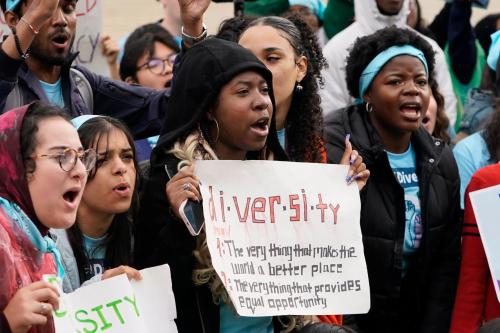If you want more content like this, subscribe to our newsletter.
This week in Class Notes:
- The intergenerational persistence of educational attainment and lifetime family income is greater when extended family networks—including cousins and siblings—are examined.
- Enrollment and completion rates dropped in California’s community colleges during the pandemic—especially among Black and Latino students.
- Minority teaching assistants in STEM subjects reduce course drop rates and increase course completion rates among minority students.
- This week’s top chart shows that six states gained seats and seven states lost a seat in the U.S. House of Representatives.
- The New York Times Editorial Board argues that the SALT deduction is regressive and should therefore be eliminated in this week’s choice op-ed.
- Check out our latest piece on how unemployment insurance helps individuals supplement lost income while also helping the greater public good by reducing COVID-19 transmission rates.
- For your calendar: Watch upcoming webinars on improving public-sector apprenticeships, environmental justice, and protecting workers’ rights.
The intergenerational persistence of educational attainment and lifetime family income is greater when extended family networks—including cousins and siblings—are examined
Traditionally, intergenerational studies of social mobility have focused on the relationship between parent and child outcomes. More recently, scholars have started linking grandparents’ outcomes to parent and child outcomes when the data allows it. But no studies have directly measured intergenerational mobility using outcomes for a broader extended family, or dynasty. Using an impressive data set that covers the entire Swedish population from 1968-2009, Adrian Adermon, Mikael Lindahl, and Mårten Palme measure the intergenerational persistence of several human capital outcomes, including years of schooling, lifetime family income, and occupation. Instead of simply linking child and parent outcomes, the authors link child outcomes to the outcomes of their parents as well as their parents’ extended families—siblings (and their spouses) and cousins (and spouses). They find that long-run persistence of human capital is much stronger than estimates using only child-parent data. The intergenerational persistence of years of schooling, for example, between extended family in the parental generation and children is .52. The persistence rate is even higher for lifetime family income and occupation. The authors also look at the effects of the extended family in the grandparent generation and find that nearly all of the long-run persistence can be explained by the parent generation’s effect on children. Finally, using data from families with adopted children, the authors estimate that at least 1/3 of intergenerational persistence can be attributed to environmental factors.
Enrollment and completion rates dropped in California’s community colleges during the pandemic—especially among Black and Latino students
Over half of all minority students in the country are enrolled in community colleges. Understanding the effects of the COVID-19 pandemic on these institutions is therefore essential for policymaking on higher education and racial equity. Enrollment in for-profit colleges and the University of California system increased in fall 2020, but George Bulman and Robert W. Fairlie show that the opposite is true for community colleges. Using administrative panel data from California’s 116 community colleges, which enroll over 2 million students per year, they find that enrollment dropped by 4% in spring 2020 and 15% in fall 2020. Interestingly, community colleges with large online presences before COVID-19 faced similar declines in enrollment. Black and Latino students faced the largest drops in enrollment, at 17% for both in fall 2020. For students who were already enrolled, withdrawal rates increased, which caused the completion rate to drop. While education, art, and basic-skills courses saw the largest declines in enrollment, science, business, and academic courses transferable to four-year institutions saw the smallest decreases.
Minority teaching assistants in STEM subjects reduce course drop rates and increase course completion rates among minority students
The share of college students that are Black or Latino has grown steadily, yet racial diversity among faculty in higher education still remains low—especially in STEM departments. To understand the effects of representation on student outcomes, Daniel Oliver, Robert W. Fairlie, Glenn Millhauser, and Randa Roland collect data from over 4,000 students taking an undergraduate introductory chemistry course at a large public university between 2014 and 2019. The authors rely on the fact that students are essentially randomly assigned to different labs, which meet regularly throughout the semester and are led by a teaching assistant (TA). The authors find that underrepresented minority students are significantly less likely to drop and more likely to pass the course when they are assigned to a lab section taught by an underrepresented minority TA. These effects are largely driven by Latino students interacting with Latino TAs. The authors find no evidence of effects on grades or medium-term educational outcomes. Minority TAs seem to improve completion rates among minority students through behavioral mechanisms that reduce the drop rate, rather than through improving grades.
Top chart: 6 states gain seats and 7 states lose a seat in the US House ofRepresentatives
This week’s top chart from FiveThirtyEight shows the states that gained or lost seats in the U.S. House of Representatives. The reapportionment occurs every 10 years and is based on population trends measured in the Census. Texas is the only state that gained or lost more than one seat (gaining two).

Choice opinion: The SALT deduction is regressive and should therefore be eliminated
“Proponents of an unlimited SALT deduction say they are seeking to help middle-class taxpayers. If so, they should go back to the drawing board. The top 20 percent of American households, ranked by income, would receive 96 percent of the benefits of the change, according to a detailed analysis by the widely respected Urban-Brookings Tax Policy Center… [T]he rise of economic inequality has increased our focus on the distribution of taxation and led us to a different conclusion: Instead of eliminating the SALT deduction cap, Congress should eliminate the deduction,” writes the New York Times Editorial Board. Of course, we agree.
Self-promotion: Unemployment insurance helps individuals supplement lost income, but it also helps the greater public good by reducing COVID-19 transmission rates
One of the most important federal government responses to the COVID-19 recession has been the enhanced unemployment insurance program, now extended until the first week of September 2021 under the American Rescue Plan Act. Unemployment insurance is vital to the U.S. economic recovery for several reasons. It provides relief to the millions of Americans who have lost jobs due to the recession and are struggling to pay for their rent and buy food. But it also has a positive externality for society as a whole because it helps keep individuals at home, which in turn reduces COVID-19 transmission rates. The pandemic creates a unique situation in which, as Mallika Thomas writes, “[t]he public, at large, benefits exponentially from each individual who can afford to turn down a job that would otherwise have increased community transmission rates.” Many of the industries that have high levels of job vacancies and are struggling to find employees are also the highest-risk industries in terms of COVID-19 exposure. These industries include health care and social assistance, accommodation and food services, construction, and transportation. To help contain further transmission of COVID-19, Thomas suggests increasing federal supplements to unemployment benefits in hotspot regions that are still experiencing high levels of COVID-19 cases. These regional supplements can gradually decline as more and more Americans get vaccinated.
For your calendar: Improving public-sector apprenticeships, environmental justice, and protecting workers’ rights
Accelerating public-sector apprenticeships
Tuesday, May 11, 2021 2:00 PM – 3:00 PM EDT
Urban Institute
Environmental justice: Energy equity and transitions
May 12, 2021, 12:00 PM – 1:00 PM EDT
Resources for the Future
How to strengthen US labor standards enforcement to protect workers’ rights
May 20, 2021 2:00 PM – 3:30 PM EDT
Washington Center for Equitable Growth








Commentary
Class Notes: Dynastic human capital, community college enrollment, and more
May 6, 2021